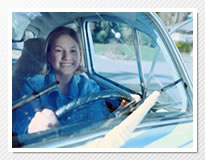Links
Centers for Disease Control and Prevention (CDC)
http://www.cdc.gov/motorvehiclesafety/teen_drivers/index.html
http://www.cdc.gov/parentsarethekey/index.html
Motor vehicle crashes are the leading cause of death for U.S. teens. Parents Are the Ke to Safe Teen Driversy, a campaign from the Centers for Disease Control and Prevention (CDC), helps parents, pediatricians, and communities keep teen drivers safe on the road.
DriveitHOME
https://www.nsc.org/road/resources/dih/driveithome
DriveitHOME is an initiative of the National Safety Council, designed by and for parents of newly licensed teen drivers. DriveitHOME offers free resources parents can use to help their teen build experience to become safer drivers. It also is a place parents can share their ideas for keeping teens safe behind the wheel.
DRIVE SMART Virginia
http://www.drivesmartva.org/
DRIVE SMART Virginia is a non-profit organization dedicated to educating drivers and raising traffic safety awareness in order to save lives and reduce injuries on the roadways of Virginia.
Ford Driving Skills for Life (Ford DSFL)
http://www.drivingskillsforlife.com/
Ford Driving Skills for Life (Ford DSFL) was established in 2003 by Ford Motor Company Fund, the Governors Highway Safety Association, and a panel of safety experts to teach newly licensed teens the necessary skills for safe driving beyond what they learn in standard driver education programs.
Insurance Institute for Highway Safety / Highway Loss Data Institute
http://www.iihs.org/
http://www.iihs.org/iihs/topics/laws/graduatedlicenseintro?topicName=teenagers
The Insurance Institute for Highway Safety (IIHS) is an independent, nonprofit scientific and educational organization dedicated to reducing the losses — deaths, injuries and property damage — from crashes on the nation's roads. The Highway Loss Data Institute (HLDI) shares and supports this mission through scientific studies of insurance data representing the human and economic losses resulting from the ownership and operation of different types of vehicles and by publishing insurance loss results by vehicle make and model.
It Can Wait Campaign (from AT&T)
https://about.att.com/csr/itcanwait
Take the pledge to never drive distracted, because distracted driving is never okay.
Teen Driver Safety, AAA Exchange
https://exchange.aaa.com/safety/teen-driver-safety/
As a parent, you can make a difference. The single most important step you can take to protect the life of your teen is to be actively involved in the learning-to-drive experience. According to research, teens value the opinions of their parents most of all (even if it doesn’t always seem like it). That’s why sharing your knowledge and experience about safe driving is so important. Now is the time to begin a potentially life-saving dialogue with your teen.
Mothers Against Drunk Driving (MADD)
http://www.madd.org/
https://www.madd.org/virginia/
Mothers Against Drunk Driving (MADD) is the nation’s largest nonprofit working to protect families from drunk driving and underage drinking.
Risky Driving
National Highway and Traffic Safety Administration
https://www.nhtsa.gov/risky-driving
Read about all types of risky driving, including DISTRACTED DRIVING.
Teen Driving
National Highway and Traffic Safety Administration (NHTSA)
https://www.nhtsa.gov/road-safety/teen-driving
After spending years protecting your children from all sorts of dangers on the road and off, parents eventually face the prospect of handing them the keys to the family car. It's time for them to learn how to drive. Are you prepared? NHTSA)can help you mold your teen into a safe and capable driver.
Teen Driver Source (Center for Injury Research and Prevention at the Children's Hospital of Philadelphia Research Institute)
http://teendriversource.org/
The Teen Driving Safety Research program provides parents, teens, educators, and policymakers with the latest information and tools to help prevent teen driver crashes. Teen Driver Source is frequently updated as new research is published, interventions are evaluated, and new resources and recommendations for families and stakeholders about teen driver safety become available.
Teenager’s Guide to Auto Insurance
https://www.scc.virginia.gov/getattachment/0cf385c3-6a45-49ea-8ba5-f01d6f132cd0/auto_teen.pdf
The basics about auto insurance are provided in this pamphlet from the Virginia State Corporation Commission Bureau of Insurance.
Virginia Department of Education (VDOE)
http://www.doe.virginia.gov/
https://www.doe.virginia.gov/teaching-learning-assessment/instruction/driver-education
The Virginia Department of Education is responsible for approving driver education programs in the commonwealth’s public and private schools. Driver education programs in Virginia schools focus on safe driving attitudes, skill development and appropriate responses to hazards. The commonwealth’s standards for driver education require extended supervised practice with a licensed parent or guardian to develop precision in the application of skills and processes to effectively manage risks.
Virginia Department of Motor Vehicles (DMV)
https://www.dmv.virginia.gov/#/
Parents in the Driver’s Seat: https://www.dmv.virginia.gov/webdoc/pdf/dmv16.pdf
Applying for a Driver’s License: https://www.dmv.virginia.gov/drivers/#applying.asp
The mission of the Virginia Department of Motor Vehicles (DMV) is to promote security, safety and service through the administration of motor vehicle and tax-related laws.
Virginia Department of Motor Vehicles YouTube Channel
https://www.youtube.com/user/VirginiaDMV
Check out the Virginia Department of Motor Vehicles many safety videos.
Virginia State Police (VSP)
http://www.vsp.state.va.us/
The Virginia State Police (VSP) web site has information on vehicle safety, state laws, criminal investigations and more.
Virginia's 45-Hour Parent/Teen Driving Guide
https://www.doe.virginia.gov/home/showpublisheddocument/1994/637949897707070000
This technical assistance guide provides parents with a systematic approach to guide their child towards remaining collision-free in both low- and high-risk driving environments. The suggested lessons in this guide follow a sequential learning pattern that progresses from the parking lot to neighborhoods, to light traffic, to rural highways, to expressways and then to city driving.
